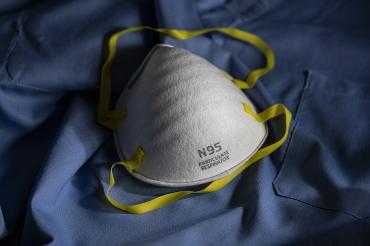Can UV light help hospitals disinfect masks and gowns? U of T researcher explains

Published: April 6, 2020
As the COVID-19 pandemic continues, hospitals are finding themselves short of masks, gowns and other personal protective equipment (PPE). Some are doing what would previously have been unthinkable – disinfecting and reusing PPE.
 One way to do this is with ultraviolet (UV) light, which is already used to disinfect patient rooms and operating theatres. In theory, it could also be applied to disinfect PPE, but as Ron Hofmann, explains, the devil is in the details.
One way to do this is with ultraviolet (UV) light, which is already used to disinfect patient rooms and operating theatres. In theory, it could also be applied to disinfect PPE, but as Ron Hofmann, explains, the devil is in the details.
Hofmann is a professor in the department of civil and mineral engineering in the Faculty of Applied Science & Engineering and an expert in the use of UV treatment in the drinking water and wastewater industries. He is also the president of the International Ultraviolet Association, which recently released a fact sheet on the role that UV treatment can play in reducing transmission of the virus.
How is UV disinfection used today?
It’s been known for more than 100 years that UV light kills microorganisms quite effectively. That includes viruses similar to the one that causes COVID-19.
It’s widely used in wastewater and drinking water treatment, and the industry is very well regulated based on decades of science and practice.
The application of UV treatment in medical care is more recent, and that’s where a lot of the research effort is going on today. Often, it’s mentioned in the context of superbugs, which are pathogens that have become resistant to traditional antibiotics.
So hospitals already have this technology?
Some do, but it’s a mix of different devices: some are stationary lamps and others are mobile or robotic. In a lot of cases, it’s working very well. But this application is not as mature as with water treatment and as a result there are fewer standards and regulations.
Like any disinfectant, it’s the dose that matters, and a lot of engineering work goes into ensuring that whatever device you’re using actually applies enough UV light to ensure that the resulting surface is safe.
How does all this relate to COVID-19?
Hospitals are now having to reuse equipment that was never intended to be reused. It needs to be disinfected somehow. UV treatment can work in theory, but it depends on whether or not it is actually being applied properly.
For example, if you put a bunch of coronavirus particles on a flat surface, a fairly economical dose of UV will kill almost all of those virus particles. But that’s an ideal case. Gowns or masks will have hidden crevices and folds where the UV light can’t get in. That scenario hasn’t been well studied.
The other issue is that repeated exposure to UV, alone or in combination with chemical disinfectants, can wear out the rubber seals that enable the mask to work properly. Right now, we don’t know how many times you can disinfect and reuse a mask before you destroy its integrity.
There are also risks associated with improper use of UV equipment. Remember, this is the same stuff that causes sunburns and skin cancer, but in a much more concentrated form. It can damage skin and it can damage eyes. The devices have to be used safely, with personnel kept well away and appropriate precautions taken.
Should hospitals use UV treatment to disinfect PPE?
The bottom line is that some treatment is better than no treatment. In the absence of anything else, if a hospital needs to disinfect its PPE and has one of these UV devices, by all means they should use it.
Ideally, UV treatment would be one step in a multi-barrier approach. That means using it in concert with other disinfection techniques, such as hydrogen peroxide treatment. That would minimize the chances that a virus particle could hide in a crevice.
It’s worth pointing out that some hospitals are running out of chemical disinfectants. The nice thing about UV treatment is that it’s there as long as you have electricity.
What is the UV research community doing?
We’re trying to synthesize the data we have to help hospitals decide how to use this technology most effectively.
In the next few weeks, there are going to be studies to try and determine best practices and results will quickly be shared. For example, my research group is talking to collaborators in U of T’s Faculty of Medicine about the mask degradation issue I mentioned.
Sterilizing and reusing PPE is something that wasn’t really considered that much until we found ourselves in this crisis, so we’re moving fast to try and figure out what works.



